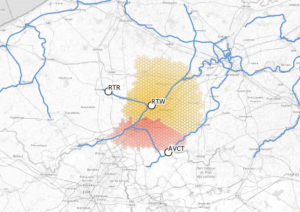English | Geo-spatial technology meets port economics
05 02 2021When people think about mobility and transport they usually envision motorways, railway tracks or even bicycle paths. However, historically one of the most important transport infrastructures is the port. Therefore, it only makes sense for Rotterdam based companies like Springco and Rebel to tell you about the way our data scientists enhance traditional port economics.
The case of West Flanders
West Flanders is an area with an extensive waterways network. Utilising these efficiently can save money, time, carbon emissions, and helps alleviate congestion. To preserve the cost-efficiency of the system, new terminals should only minimally duplicate the area coverage of existing ones, while also exposing the market to as many new businesses as possible’. Sam van Emelen from Rebel Belgium addressed this problem by building a tool to help assess the business investment opportunities related to building new cargo terminals, in terms of improving the accessibility of inland waterways to businesses.
If a new terminal is under consideration, an important task would be assessing the impact on the existing terminals in the region: Does the proposed port compete with them? If yes, does it add value? Does it improve accessibility?
Predicting market outcomes
Sam considered all cargo terminals in West Flanders in the relevant sub-region, and calculated how far a business would need to travel to get to a terminal from each point in the region (up to 30km by road for containers, 20km for bulk goods). Taking into account the most common destinations (e.g., Brugge, Antwerp, etc.) and the fraction of traffic to each of these, the tool estimates the cheapest option via a waterways terminal, given a starting location within the West Flanders region. Thus, a “sphere of influence” is computed for each existing or proposed terminal. The tool is also able to answer additional questions, e.g., what would be the impact of a sluice upgrade allowing passage of freight barges? Bulk and container cargo are also treated separately, since they require different loading/unloading facilities.

Catchment areas of River Terminal Roeselare, River Terminal Wielsbeke and Avelgem Container Terminal
For the final outcome, the tool compares the situation before and after a new terminal was built. Taking into account cargo type, whether it had a sluice upgrade, and any other considerations. In this case, Sam found that a new terminal focused on bulk goods is justified, while cargo shipping is already well-served in the region.
Exciting studies like these combine data science and geo-analytical techniques with traditional market research in order to gain insight in challenging practical problems. They lead to actionable recommendations.